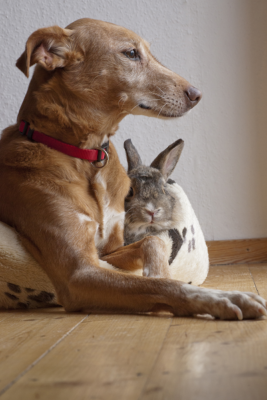
No questions asked: cancer is a 5-letter word no pet owner wants to hear. And as pets live longer, diseases that come along with aging, like cancer, can occur. National Pet Cancer Awareness Month was established to inform the public about prevention, what to look for, and how cancer is treated in pets.
Pets risk developing different types of cancer, just as humans do, and it is commonly seen in cats and dogs. Certain breeds of dogs have a higher risk of developing cancer at a young age, but most often, cancer is diagnosed in middle-aged and senior pets. Up to 70% of ferrets over the age of three will develop insulinoma, lymphoma, and/or adrenal cancer. Rabbits, guinea pigs, rodents, and birds are also at risk but are excellent masters of disguise; the cancer is likely to have already spread when they start showing signs of illness.
Over 100 types of cancers affect our animal companions. Some types of cancers diagnosed in pets are the same as those in humans, including mammary gland cancer and lymphoma; leukemia is the most common cancer diagnosed in cats.
Some common types of cancers diagnosed in companion pets are:
- Blood and lymphatic cancers (lymphoma and leukemia)
- Skin cancer
- Mammary gland (breast) tumors (in unspayed females)
- Mast cell tumors
- Bone cancers
- Oral cancers
- Abdominal organ cancer (e.g., spleen, liver)
The cause of many pet cancers is unknown, making prevention difficult; however, certain cancers can be prevented. Taking the following steps can reduce the incidence of certain cancers:
- Spaying reduces the risk of mammary gland and uterine cancer in female cats, dogs, rabbits, and other small mammals.
- Neutering eliminates the risk of testicular cancer in cats, dogs, rabbits, and other small mammals.
- Keeping your pet out of the sun, especially between 10 am and 4 pm, reduces the risk of some forms of skin cancer.
- Vaccinating your cat with the feline leukemia vaccine prevents infection with the feline leukemia virus.
- Avoid smoking inside—secondhand smoke can cause cancer in pets, too.
Early detection and treatment are the best ways to increase the life expectancy of a pet with cancer. The warning signs of cancer in pets are similar to those in humans. Sometimes there are no obvious signs, so whenever your pet appears unwell or something is unusual, check with your veterinarian. Some warning signs to look for include the following:
- General malaise and lethargy
- Lumps, bumps, or discolored skin
- Wounds that do not heal
- Enlarged lymph nodes
- Unexplained lameness or swelling of joints and bones
- Bleeding from the mouth, nose, or any other opening
- Difficulty eating
- Persistent diarrhea or vomiting
- Unexplained weight loss
Many of the above signs can be seen with conditions unrelated to cancer but still need prompt attention. If any of the above signs are observed in your pet, see your veterinarian for a diagnosis and treatment plan. Annual or bi-annual routine health checks can help your veterinarian detect subtle signs before you notice them. For small mammals and birds, routine health checks twice yearly are especially important!
Although frightening, a cancer diagnosis does not necessarily mean your pet won’t survive. In many cases, pets can be treated successfully, especially if caught early. The goal of treatment is to slow the growth or eliminate it entirely while still giving your pet a good quality of life. Cancer treatments for pets don’t have the same degree of side effects as those for humans, so don’t let the word “chemotherapy” scare you.
Take your pet to your veterinarian for regular wellness checks. Get into the habit of checking your pet over at home between check-ups – this way, you know what is normal for your pet, allowing you to seek veterinary care sooner if you notice something unusual.